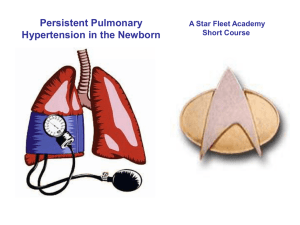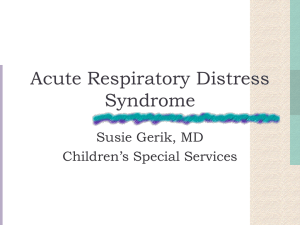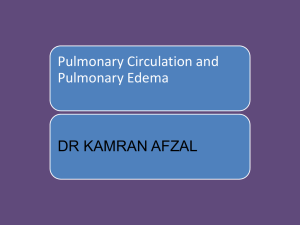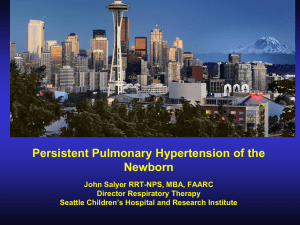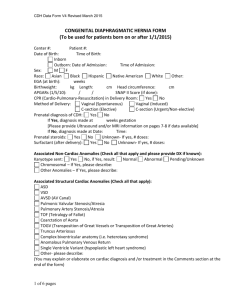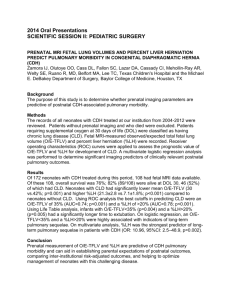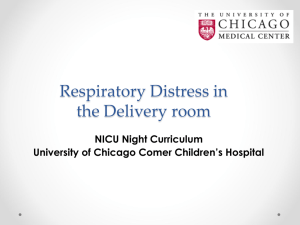Neonatal Physiology
advertisement
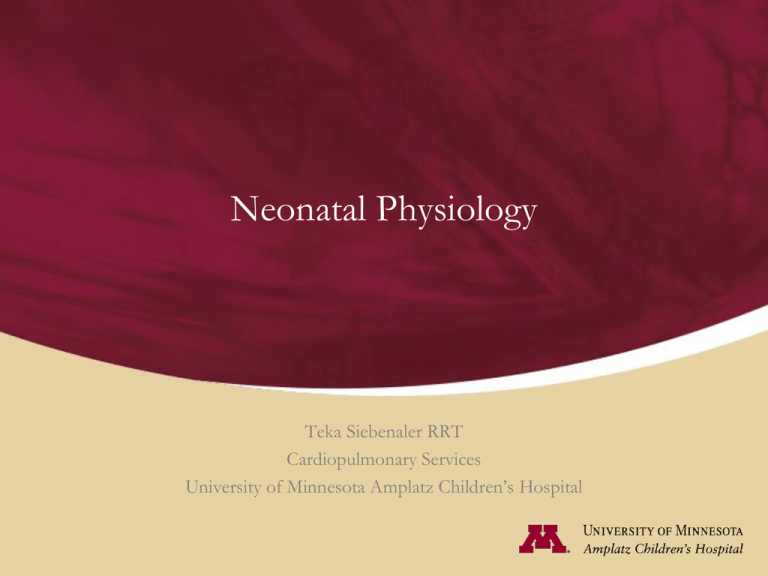
Neonatal Physiology Teka Siebenaler RRT Cardiopulmonary Services University of Minnesota Amplatz Children’s Hospital Fetal Lung Stages of Development Embryonic Stage 3rd-8th week Neural Tube closure Diaphragm and lung bud formation Internal organs in primitive formation stomach, liver, pancreas, gall bladder, bladder and intestinal loop • Vascular systems appears • • • • • Most congenital malformations occur during the 4th-8th weeks • Anencephaly/Spina Bifida • Extremity deformities • Diaphragmatic hernia (85% on the left side) Fetal Lung Development • 7-16 weeks the formation of the bronchial tree • 17-24 weeks primitive gas exchange surface forms • 24-40 weeks alveolar development continues • 35 weeks stable surfactant production Postnatal Lung Development • Newborn – Airway branching complete – Alveolar formation is not complete Age 1-10 years number of alveoli increase Age 10 to young adult lung grows larger with little alveolar growth Fun Facts • Surfactant is produced by alveolar epithelial cells (type II) • Surfactant production increases 2 weeks prior to normal birth • We are born with on 1/6th the number of alveoli we will need as an adult. Surfactant Replacement • Creates a layer between the alveolar surface and the alveolar gas and reduces alveolar collapse by decreasing surface tension within the alveoli. • Given to patients with immature lungs, MAS, RDS, Pulmonary Hypoplasia and CDH – Curosurf vs. Infasurf vs. Survanta…… Cardiac Formation • By 22 days a endocardial tube has formed • At 28 days aortic roots, primitive left atrium, pericardial cavity, left ventricle have formed • Blood begins to shunt from left to right during the 4th and 5th weeks of development • “Abnormalities in heart formation, the most common form of human birth defects, afflict nearly 1% of newborns, and their frequency in spontaneously aborted pregnancies is estimated to be tenfold higher” – Hoffman, J.I. Incidence of congenital heart disease: II. Prenatal incidence. Pediatr. Cardiol. 16, 155-165 (1995). Fetal Circulation • Fetal Circulation – Oxygenated blood from placenta via umbilical vein – 66% shunted past liver by DUCTUS VENOSUS to IVC – 50% of this blood shunted from right atrium to left atrium via FORAMEN OVALE – This blood continues to left ventricle, ascending aorta, and arteries feeding head and right arm Fetal Circulation cont’d • Venous blood from head (SVC) is directed via right atrium to right ventricle into the pulmonary artery • 90% of blood in PA is shunted away from lungs and into descending aorta via the DUCTUS ARTERIOUS and returns to the placenta via the umbilical arteries. Changes in Circulation, Respiration After Birth • Pulmonary vascular resistance decreases after birth due to: – Increased alveolar and arterial oxygen tensions, which increase nitric oxide – Lung expansion – Decrease in PaCO2 – Increase in arterial pH • Pulmonary artery pressure decreases below systemic pressure; pulmonary blood flow increases • Left and right ventricles pump in series rather than in parallel as in the fetal circulatory pattern “Normal Circulation” • Closure of Umbilical arteries w/in minutes after birth • Ligation of umbilical vein (clamped cord) • Closure of PDA (minutes to days) • Closure of Foramen Ovale due to increased pressure in Left Atrium and Decreased pressures in Right Atrium Pulmonary Hypertension (PPHN) – Occurs in 2 out of every 1,000 born live infants – Complicates the course of 10% of infants with respiratory distress – Typically seen in infant’s >34 weeks – More common in babies that were hypoxic and acidemic around the time of birth (Venous cord Ph <7.20 and BE -8) – More prevalent in infants whose mothers took NSAIDS or SSRI’s during the 3rd trimester • “Due to a patent foramen ovale and patent ductus arteriosus, which are normally present early in life, elevated pulmonary vascular resistance in the newborn produces extrapulmonary shunting of blood, leading to severe and potentially unresponsive hypoxemia. With inadequate pulmonary perfusion, neonates are at risk for developing refractory hypoxemia, respiratory distress, and acidosis.” » Robin Steinhorn, MD Cardiac Complications • Persistent pulmonary hypertension • Normal Circulation PPHN • 3 types: • Result of abnormally constricted pulmonary vasculature due to lung parenchymal diseases leading to hypoxia (mec aspiration, pneumonia, RDS) • Idopathic (10-20% of all affected infants) • Pulmonary hypoplasia or structural defects (CDH, PROM) How do you know it is PPHN? • • • • • • • Cyanosis Tachypnea Grunting Pre/post ductal split Hypoxia/hypercapnea/acidosis Response to oxygen and iNO Cardiac Ultrasound Treatment for PPHN • • • • • • • Oxygen therapy Inhaled Nitric Oxide Normal Lab Values Blood Pressure support if needed Mechanical Ventilation ECMO Time! PPHN and ECMO • Can be V-A or V-V ECMO • Typically a short run (3-5 days) • Survival rates greater than 68% as compared with 40% in infants treated with conventional nonECMO therapy • Patient needs time for the pulmonary vasculature to relax and for the patient’s heart is able to pump blood to the lungs Congenital Diaphragmatic Hernia • Occurs in 1 of every 2000-3000 live births and accounts for 8% of all major congenital anomalies. Mortality rates are 25-60%.... • The diaphragm initially develops as a septum between the heart and liver, progresses posterolaterally, and closes at the left Bochdalek foramen at approximately 8-10 weeks' gestation. • A severe CDH is believed to occur during the pseudoglandular stage of lung development. Weeks 7-17 and this is when pulmonary circulation develops. • Lung compression results in pulmonary hypoplasia (both lungs may be abnormal). Pulmonary hypoplasia is associated with fewer bronchial generations, alveoli, and arterial generations. Left Sided Congenital Diaphragmatic Hernia Left CDH CDH and ECMO • Typically VA ECMO • Can be a difficult cannulation due to small vessels and cardiac anatomy • Average run time 181-197 hours and 50% of patients with a CDH are treated with ECMO • Patients are often decannulated and immediately repaired on the NICU • If patient is not repaired by 14 days-survival rates rapidly decline ECMO and Respiratory Failure • Meconium Aspiration Syndrome • Sepsis • Pneumonia • Alveolar Capillary Dysplasia ****All have a component of PPHN****** Alveolar Capillary Dysplasia • Very rare lethal congenital anomaly • Failure of formation of the normal air-blood diffusion barrier in the newborn lung. Alveolar Capillary Dysplasia is usually associated with "misalignment" of the pulmonary veins. • Patient will not repond to mechanical ventilation, iNO or ECMO • 75% of these patients will have other organs affected • Longest reported survival is 2 months post ECMO run • Questions??????
